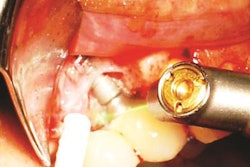
Laser therapy has numerous applications and may improve oral wound healing by encouraging cell regeneration, lessening pain, and modulating the immune system, but its use after tooth extraction remains controversial. Therefore, researchers reviewed the published literature to learn more about the evidence for this treatment.
They searched for studies conducted in humans or animals that examined whether laser therapy improved wound healing after tooth extraction. However, they found results that were positive yet limited. Their review was published in Wound Repair and Regeneration (October 15, 2018).
"The current available evidence in the literature demonstrated that laser therapy improved the wound healing process, but these findings were limited to the type of laser applied and its specific settings," wrote the authors led by Carmen Helena Jacques Lemes, a professor in the department of buco-maxillofacial surgery at the Federal University of Pelotas in Brazil.
Healing the wound
Alveolar wound healing after tooth extraction is complex, and previous studies have suggested that laser therapy could accelerate and improve this process while also providing patients with greater comfort. It may be particularly useful as an adjuvant treatment for patients who are immunocompromised, such as those who are HIV-positive or have diabetes, the review authors noted.
At the same time, despite the many applications of therapeutic lasers, their use for improving the wound-healing process after tooth extraction is not widely accepted. The researchers assessed the best evidence by searching in numerous medical databases for studies conducted in humans or animals on the use of laser irradiation after tooth extraction published in English, Spanish, or Portuguese. They only included studies that included one group that underwent laser therapy and at least one control group that did not receive this treatment.
They identified 16 studies for inclusion, eight of which were conducted in humans and eight in animals. A meta-analysis was not included because of the variety of lasers and settings.
Among the studies conducted in humans, six used a split design and two had parallel groups. The studies included 461 patients who underwent more than 480 tooth extractions. Healthy patients served as study subjects in seven studies and HIV-positive patients in one study. Seven studies looked at alveolar healing after molar extraction in individuals up to age 65, and one study focused on healing after premolar extraction in 12- to 18-year-olds.
“Studies currently available demonstrated that laser therapy might improve the wound healing process and reduce swelling and pain after tooth extraction.”
Investigators randomly assigned treatments in six studies. They treated study participants with low-level laser therapy with gallium-aluminum-arsenide, hydrogen fluoride, helium-neon, or diode lasers and followed them for one day to six months.
The results of four studies indicated that hydrogen fluoride, diode, and gallium-aluminum-arsenide lasers improved wound healing at the settings evaluated. However, the other four studies showed no evidence that gallium-aluminum-arsenide or helium neon lasers did so.
Among the included studies on the effects of laser therapy on animals, six examined the treatment in healthy rats and two in animals with diabetes or that had previously undergone radiotherapy. The studies looked at the effects of carbon dioxide, gallium-aluminum-arsenide, neodymium-doped yttrium aluminum garnet (Nd:YAG), helium-neon, and high-frequency pulsed diode lasers in 269 animals and 326 teeth, which were usually molars. One study examined the initial application of high-level laser therapy to coagulate blood and prevent loss of blood clots.
During follow-up of six hours to 21 days, all studies in animals found that laser therapy helped the wound-healing process after tooth extraction except for one performed with a helium-neon laser. Overall, laser therapy with carbon dioxide, gallium-aluminum-arsenide, Nd:YAG, and high-frequency pulsed diode lasers improved wound healing and bone repair compared with control treatment.
Study quality limited
The quality of the evidence in the included animal studies was limited, with many of these experiments not blinded or randomized, the review authors noted. Additionally, in most studies in humans, participants and the outcome assessment were not blinded. Also, the benefits of low-level laser therapy for wound healing were found only with certain types of lasers.
Laser therapy may be beneficial, but more studies are needed, they wrote.
"Studies currently available demonstrated that laser therapy might improve the wound healing process and reduce swelling and pain after tooth extraction," the authors concluded. "However, most of the positive evidences were derived from animal experiments with findings limited to the types of lasers evaluated with specific settings, which emphasized the need for further well-designed and randomized controlled trials relative to this topic."



















